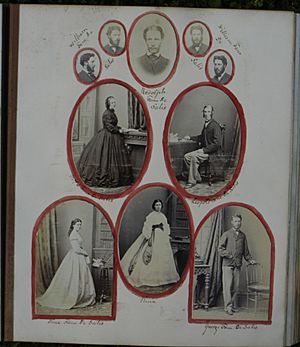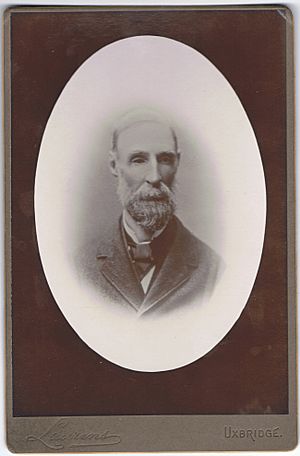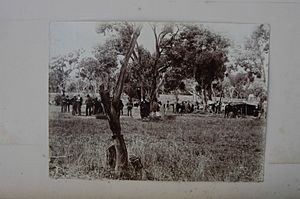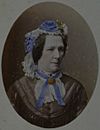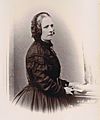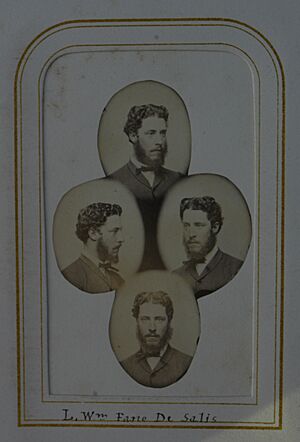Cuppacumbalong Homestead facts for kids
Cuppacumbalong is a very old homestead near Canberra in the Australian Capital Territory. It was once a large sheep and cattle farm covering about 16 square kilometers. The name Cuppacumbalong comes from an Aboriginal word meaning 'meeting of the waters', because it's located where the Murrumbidgee and Gudgenby Rivers meet.
This place is important because of its history. One of its early owners, Leopold Fane De Salis, was a significant person in politics long ago. Cuppacumbalong also has strong links to William Farrer, who is known as the father of Australia's wheat industry.
Contents
Early Owners: James Wright
James Wright, from England, came to Australia in the 1830s. In 1833, he and his friend John Lanyon were among the first 'squatters' to set up sheep farms in the Queanbeyan area. Squatters were people who settled on land without officially owning it.
In 1839, James Wright started Cuppacumbalong on the southern side of the Murrumbidgee River. Back then, this area was outside the official boundaries of New South Wales. Even so, many squatters raised lots of sheep and cattle there. By 1848, James Wright faced money problems. He sold his other farm, Lanyon, and focused on Cuppacumbalong. He then sold Cuppacumbalong to the de Salis family in 1855.
The De Salis Family at Cuppacumbalong
Leopold Fabius Dietegen Fane de Salis (1816–1898) was a farmer and politician. He was born in Italy in 1816. Leopold went to a famous school in England called Eton College. He then studied sheep farming in Scotland.
In 1840, when he was 24, Leopold moved to New South Wales. He bought several large farms and helped open up new areas for farming. In 1844, he married Charlotte MacDonald. They had five children. In 1855, the de Salis family bought Cuppacumbalong and moved there.
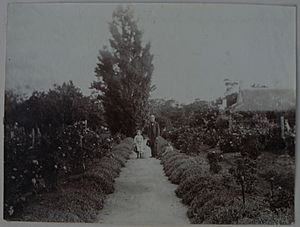
Cuppacumbalong became known for its excellent wool and strong horses. Leopold made many improvements to the farm. He started using irrigation for crops and built dams for water. The homestead was close to the river, so it flooded several times while the de Salis family lived there.
New laws were introduced to help smaller farmers get land. Leopold quickly registered parts of the land under his family's names. This way, he kept control of the valuable river flats. He turned his squatter farm into a permanent, owned estate.
Leopold's only daughter, Nina, married a scientist named William Farrer in 1882. Leopold gave the couple about 97 hectares of his property. They named their new farm Lambrigg.
The de Salis family also bought other large farms in the area. Leopold's brother, William Fane De Salis, helped him with money. William had important jobs in London, including leading a bank.
Leopold de Salis was elected to the New South Wales Legislative Assembly for Queanbeyan from 1864 to 1869. Later, he was appointed to the New South Wales Legislative Council in 1874. He worked for 24 years in politics. He wanted to change taxes, suggesting that workers should pay an income tax.
The de Salis family faced tough financial times in the 1890s. They lost their farms in Queensland in 1892. Leopold visited England in 1893. The de Salis family stayed at Cuppacumbalong until 1894. Leopold faced serious debt before he passed away.
A street in Canberra, De Salis Street in Weetangera, is named after Leopold de Salis.
New Owners in the 1900s
In the early 1900s, Cuppacumbalong had two new owners. Fred Campbell and Colonel Selwyn Campbell owned it with George Circuitt for 13 years. In 1911, they sold the large 85 square kilometer property to A.G. McKeahnie.
Later, a new owner named Alan Thomson bought the property. Thomson built a brand new homestead high above the Murrumbidgee River. He then tore down the old homestead.
The Snow Family Era
Frank Snow, from Ballarat, bought Cuppacumbalong in the early 1920s. He added many parts to the Thomson homestead. This modern house had beautiful views of the countryside from its terraces.
The Snow family welcomed many famous international guests. These included Anthony Eden, who later became the UK Prime Minister. Also, Princess Elizabeth (who became Queen Elizabeth II) and Prince Philip, Duke of Edinburgh visited during their Australian Royal tour in 1952.
The Snow family continued the tradition of raising wool. They had about 7,000 Merino sheep and 300 Hereford cattle. They also had a small stud farm for Romney Marsh sheep. In the late 1960s, Cuppacumbalong was one of the largest privately owned farms, covering about 31 square kilometers.
Cuppacumbalong's Commercial Uses
In the 1970s, the Australian government took back the leases for several historic properties, including Cuppacumbalong Homestead. In 1975, Karen O’Clery leased the homestead. She started the Cuppacumbalong Craft Centre. It had a cafe, rooms for art shows, and studios for artists. Later, a shop opened to sell crafts.
In 1999, the lease changed, and Cuppacumbalong Homestead became a restaurant and a place for weddings. A separate small gallery still showed and sold Australian crafts. However, after the terrible 2003 Canberra bushfires, the Tharwa Bridge closed. This made it very hard for businesses, and both Cuppacumbalong businesses stopped operating.
In 2007, the new people leasing the property planned to turn the homestead into a private home. They also wanted to build a separate gallery and a cafe. By 2016, the bridge had reopened, and the buildings were available for tourists to rent for short stays.
A Protected Heritage Site
All three Cuppacumbalong homesteads are important historical sites. This includes the remains of the first homestead built by James Wright, the second by the de Salis family, and the current one. They are all listed on the Australian Capital Territory Heritage Register.
The Heritage Register says that the remains of the first two homesteads are important archaeological sites. They show how the area was first settled. The current homestead, built in 1923, is a good example of the "Inter-War California Bungalow" style. This style is quite rare in the ACT.
The de Salis family grave is also at Cuppacumbalong. About 16 people connected to the de Salis family, including Leopold and his wife, are buried there. The de Salis family also planted many Lombardy poplar trees along the riverfront at Tharwa.


